Detailed information covering the various murder scenes is readily available from other sources with resulting evidence being quite compelling as to what actually happened. From my point of view after studying police photographs, promising and vital evidence was overlooked as it didn’t necessarily fit the police agenda . . .
First, and of particular interest to me, was the lack of scrutiny involving the wheelbarrow, an old oilskin (or parka) and the tendril bush by the gate near the back door.
To set the scene I am using the following extract from the 1980 report of the Royal Commission which officially outlined the situation at the time. This is what paragraph 428 said: “When the Police commenced their inquiries into the Crewe murders they took a substantial number of photographs of the scene as they first found it. Several of these photographs show some cloth or material with ragged edges lying on the grass alongside a wheelbarrow near the back door of the house. The Police considered the wheelbarrow was used by the murderer, for flakes of rust from it were found by the front door adjacent to some blood stains. Also, it gave the appearance of having been washed.”
The Commission goes on to say that the ragged material was examined visually by police but they saw nothing that obviously connected it with the murders so literally ignored its significance. Added to that they said the material never became an exhibit or was tested in any way.
My immediate response in reading this was still one of disbelief even though I had previously had the same feeling that a lot of so-called evidence would eventually end up somehow as actual facts.
The most disappointing feature was the lack of any reference to these items on the police file which meant nobody was aware of its existence. The Commission also considered the police had a duty to advise the Defence of its ultimate fate and to give them the opportunity of finding witnesses who could give evidence about parka. But they didn’t!
IMPORTANT EVIDENCE
The photo taken by the police of the house is showing the two items just mentioned. The wheelbarrow by the back door steps also shows what looks like a coat. The police said it was an oilskin while another says it was a cow cover. I don’t know personally what it was but for the ease of description I’m going to refer to it as a parka (a large windproof jacket with a hood).
It was very tattered whatever it was but the thought did go through my mind that the parka could easily end up being a red herring. Its use could have simply been a cover to keep the firewood dry on its way to the home fireplace and had nothing to do with the murders.
Perhaps though, it wasn’t a red herring. Perhaps it held important clues. Nobody will ever know as early on in the investigation the parka had mysteriously disappeared. Why? Did somebody realise on closer inspection it would point the finger so it had to disappear? It would have been incredibly risky to smuggle it away from the scene. One has a tendency to believe the police explanation that it was accidentally burnt by a policeman casually throwing away his cigarette butt or maybe its demise could have been quite the opposite–deliberate.
The Commission were told that the parka was “completely consumed, leaving only charred grass behind it.” Because of dampness they did not believe that unaided a cigarette butt could have caused a fire which “completely consumed the material including a long ragged tendril lying out to one side on its own.”
From other evidence they, the Commission, believed that some person with an interest in the material returned to the scene and was responsible for its destruction or removal.
I was also told that other parts of the tendril bush (apart from the long ragged piece) had signs of being burnt. The smouldering or burning parka could have been picked up from the lawn and thrown in the bush where it burnt out. On the other hand, there could have been blood in the tendril bush that also needed destroying.
The opportunity to dig a little deeper for clues was regrettably lost. Sadly, to the police, it didn’t require further investigation or even worth recording
Think about it, if there were any disturbances left on the ground, the rain would have since washed most of it away especially blood and other particles of interest. Also flattened grass, boot marks, any damage to shrubs made by the wheelbarrow, or from a falling body, would have been lost. Rub marks would have weathered, cobwebs replaced and the smell of something unnatural would have disappeared in the wind.
To the hunter all these things are recognised from experience. The sight and scent of an area that is five days old and through nature, can and will hide many secrets.
IT DOES DEFY BELIEF
So, who was this mystery person? Who ‘fixed’ things? One name comes immediately to mind (Len) and another is close behind–the murderer! This person has a familiar face, lives in the area and would not raise too much suspicion by wandering around the site.
I have been struggling for over four decades to join up enough dots to hang the offender(s) and while I’m close to blurting out what I believe to be the truth, I was heartened by comments made by Mr Justice Henry during an interview with David Yallop for his 1978 book Beyond Reasonable Doubt (page 192). Here’s what he said:
“It was to my mind a local murder. No stranger could have gone on to that farm, committed a double murder and carried out the various acts that were unquestionably carried out. How all that was achieved by the murderer I will never know. No one saw or heard anything. It defies belief.
“It was truly extraordinary that there was no forensic evidence to link Thomas to the murders. No prints, no hair, no blood. They usually leave some trace somewhere. But in this case not a single thing anywhere. No clothing of Thomas destroyed, and who ever did it must have been covered in blood at some stage. It defies belief.”
Mr Justice Henry had echoed the same thoughts I have been harbouring for decades and while he has used the name of Arthur Thomas, it could easily apply to anyone local, somebody not even suspected. We all now know that Thomas was not the murderer so obviously the perpetrator’s name(s) is/are still out there!
I have always believed locals were donkey deep in this double tragedy, that’s why I have relentlessly pursued the angles covered so far in this book and I’m not finished yet. There are more surprises to come, many of which have come from clues given by the public but not followed up by the police as shamefully it didn’t fit their Demler or Thomas agendas.
DEMLER’S BIG MISTAKE
The other name belongs of course to Len Demler, the man police wanted desperately to nail for the crime. I keep saying that Len was most certainly implicated, in fact, he had no alibi for the days following and to me was a logical suspect. He now seemed to take it upon himself to cover butts by tidying up the loose ends.
I had some of my suspicions confirmed when Len unconsciously stated at the first trial of Arthur Thomas that he identified the recovered body of Harvey Crewe with these words: “I couldn’t recognise any of the clothing, but the gumboots were the type he wore.”
Without realising it Len said Harvey was wearing gumboots when in fact police had described him as wearing socks (no gumboots) plus a blue knitted pullover, trousers, a singlet, underpants and a green checked shirt.
Demler later retracted the gumboot statement and changed it to “hand-knitted socks”. Everyone seemed to believe it was a genuine mistake, that is, apart from myself and probably a few others who saw this as another of Len’s verbal blunders.
To me it wasn’t just a slip of the tongue as Len was simply recalling where he had last seen Harvey’s feet. The vision in his mind was fixed on his gumbooted feet protruding from the tendril bush beside the side gate (pictured above).
This is where I believe Harvey was shot and in making this bold statement yet again I want to back this up by putting forward another possible solution to the puzzle, a notion I have always believed in, as to how Harvey Crewe died and where.
It all started many years ago when, in conversation with others on the subject, someone confidently said, “Oh! Harvey wasn’t shot in the house anyhow.” I thought that was a strange comment as that person had later lived in the same house but in considering his status in the community I figured his unsolicited remark was worth following up.
This clue had initially given me a completely different line of thought and since several decades have now passed I am reminded that nobody has really worked out what actually went on in the Crewe lounge. From information that I have already revealed or hinted at in this book it would be timely to bring my thoughts up to date by using some country logic and common sense.
SETTING THE SCENE
I have earlier spoken about a number of unhappy people who had borrowed finance from the Chennells Estate and leading up to the death of Maisie Demler, their debts were being called in. Events were literally starting to heat up.
Readers will recall a series of mysterious fires and other mischief against the Crewes that resulted in Maisie’s grouch of “what are they going to do next?” The key word here was “they” and from the few personal items stolen indicated a woman was involved.
Added to this was a fire that was started in Rochelle’s bedroom suggesting someone who had knowledge of family movements was brazen enough to enter the home in broad daylight, strike some matches then escape without being seen.
I have narrowed this down to the local couple who duly arrived at the Crewe home for serious discussion. The pair had known Len and Maisie Demler from earlier dealings and along with the Crewes had visited their respective homes more than once. They were likely related and there was probably more than two of them.
They were expected on this Wednesday evening in June 1970 so there was no need for any stealth, surprise entrances nor even being someone who had a reason to shoot at them through their louvre window.
On this occasion though, and because of Jeannette faithfully carrying out her mother’s wishes, the Crewes would have felt some trepidation or even apprehension in facing their opponents. The subject under discussion was going to be rather touchy and needed to be diplomatically dealt with in a tactful but forceful way without being self-defeating. I don’t think that the Crewes would ever have imagined though, that their lives were in danger.
MEANS OF ARRIVAL
I could pad this out by trying to speculate on the drama as it unfolded but almost like everybody else I wasn’t there. I now believe there were at least three or four people present, and probably some of them over the next days and through the weekend, including Len.
Readers who have read all the reports will no doubt jump on me as there is no absolute proof that so many people were present. The deductions have been that only three people including the Crewes were present as the dining table had food for three but only two had eaten. When the police arrived on Monday it appeared only three seats had been used to watch TV.
Regardless of numbers, their means of arrival has also puzzled me as there were no reports of a vehicle parked in the Crewe driveway on that fateful evening although there was a lot of passing traffic from other functions plus reports of several cars seen parked further down the road. As part of their investigation the police did compile a list of all the cars that were seen in the district but chose to keep this information mainly to themselves.
It could be a totally different story if Len Demler was initially involved. He could have easily been the third person with the meal being intended for him but the distraught couple arrived either with Len or shortly after.
The visitors could have left their vehicle at his house then entered by the back way as Len had a common boundary with the Crewes. It is local knowledge that Len has, at times, advised others not to go by road from his place but to go by foot through the bush as it is “not so conspicuous”.
The question is, “Did Len go as far as escorting the couple? If he did then Len has put himself deeper into the mire and if that’s true he was hardly going to tell the truth when questioned which means it will now be impossible to prove.”
Just how events actually unfolded will probably never be known but the situation must have eventually built up to such an explosive point where it basically ended up where, dare I say it, a likely “do or die” ultimatum had to be given to settle the dispute.
THE WEAPON USED
Someone obviously “lost it” bad enough to commit a double murder but one has to ask where the weapon suddenly appeared from?
If it was premeditated then an easily concealed pistol would halt everyone in their tracks or if Demler was present, he would have left the .22 rifle (the one police couldn’t prove that he owned), at the back door just in case it was needed. On the other hand, the murderer could have left his rifle at the same spot.
A rifle would have been difficult to conceal on one’s person so another alternative for the killer was to use one of Harvey’s firearms. He was known to have a shotgun, clearly shown in a police photo resting on coat hooks next to the fridge in the laundry. He was also believed to own a .22 rifle but no trace of it could be found. The police must have known whether it existed or not.
Demler was questioned heavily in court whether Harvey actually owned a .22 rifle. His answer was consistently “not to my knowledge” which doesn’t mean yes or even no. This .22 has never been found nor, in fact, has any murder weapon been positively identified. Both could still be hiding undiscovered somewhere in the Waikato River or buried out of sight. It’s reasonably unlikely that the murderer would retain the murder weapon after disposing of the bodies.
My belief is that all the above is not relevant if a pistol was used.
NO SIGNS OF GUNFIRE
Remember, official records claim that Harvey had been shot in his chair, the bullet travelling from left to right with an exit discharge very close to the door jam or wall yet no blood discharge or bullet fragments were found in that location, at head height or elsewhere in the house.
The police had also completely stripped Harvey’s chair and failed to find any trace of a bullet in the material or structure of the chair.
As I’ve mentioned a couple of times previously, the probable reason for this is that Harvey was not shot inside.
The police tried exceptionally hard to claim that Harvey was shot through the louvre window while dozing in his chair. We now know this to be a fallacy and extremely unlikely.
Again, my opinion for what it’s worth, is that an unknown person was holding the gate open for someone with a load of firewood on a wheelbarrow to come through and with his hands occupied (and head down pushing the barrow), and with no side vision because of the parka, the man was vulnerable and defenceless.
Harvey was caught totally unaware and with a pistol shot behind and slightly above the left ear, his body hit the inside of the fence and landed between the tendril bush breaking or dislodging the bottom rail. This would have left his gumboots protruding to be seen later by Len in torchlight.
Both the wheelbarrow and parka may have revealed more clues particularly if the parka hood had been closely examined especially within the area behind the ear. A little hole in the fabric may have revealed the truth or told a completely different story. Unfortunately we will never know.
PATTERN OF SILENCE
In this case, from day one to the last day, there has been a line of events I am calling a pattern. And yet there are people out there more qualified than myself on the subject who for some reason have kept a still tongue in their head. Maybe we should call it the pattern of silence. Much more on this later.
After dealing with Harvey the killer left him where he fell then hurriedly came from outside through the back door past his accomplice(s) and confronted Jeannette in the lounge where she had tried to defend herself, hence the smash in the face that knocked her senseless to the floor where she was eventually shot.
I’m aware that a pistol, my weapon of choice, would hardly cause the serious damage Jeannette received but a heavy piece of wood from the wheelbarrow could have been a handy alternative then destroyed in the fireplace later along with other incriminating evidence.
There is also circumstantial evidence of a fight that involved Leslee too.
DRAG MARKS ARE REVEALING
It is soon realised that Harvey’s body was still lying outside and it being too risky to wrap him up in bed material where he fell, it was decided to bring him inside where it was safer. Both bodies could then be dealt with behind closed doors.
It is agreed Harvey Crewe was in the armchair for a period of time after death. But this does not mean that he was in the chair at the moment he was shot.
Harvey would have been bundled into the wheelbarrow after being taken to the front door. Drag marks shown in police photographs are detailed enough to show the direction of pull. It is perfectly clear that this was an outside to inside dragging! Harvey was killed OUTSIDE and dragged in, just as the later occupier of this house had told me, personally.
Again the rust found on the porch from the wheelbarrow indicated pulling of a body out of the wheelbarrow at the front door, not the reverse. Rust dropped as a result of pulling Harvey’s body OUT of the wheelbarrow, not while putting it IN!
The view showing the broken apart TV lead also to my mind indicates an outside to inside pull. If Harvey’s body was being dragged out, the lead would be in a different position. In actual fact, like the position of the furniture after five days of activity, nothing was probably in its original position after the shots were fired.
I have never claimed to know all the facts and what I am saying may mean something to those with an open mind. However, the experts will maintain the direction of pull was solely from inside to outside and that the crime was committed by a single person which basically means that Len Demler fitted the MO perfectly as “the local” with the most to gain.
Details given in Keith Hunter’s book The Case of the Missing Bloodstain is essential reading to bring balance to my comments and it is quite easy to agree with his logic and conclusions. I am willing to rest my case but the fact remains that the Crewes are now dead and a decision had to be made to dispose of their bodies.
SHIFTING THE BODIES
As I said, the reason for removing the bodies has been another area that has tested my grey matter and the only way I found to connect up some of the dots was to believe what Leslee said to me later in our relationship about how she hated woolsheds.
The police couldn’t discover what means were used to remove the bodies nor could they establish when the weights were tied to their bodies or where on the Waikato River they were dumped.
I have my own ideas on how this happened but at the end of the day it is only speculation and quite devoid of hard fact. I shall call it another point of view or if I’m honest, frustrated opinion!
After the bodies had been wrapped in bedding and not necessarily bound with wire at this stage, the wheelbarrow was, in the first instance, supposedly used to cart the bodies from the front door to some means of transport ready for disposal in the river.
Although a short piece of wire was found at the front gate, it does not mean the wire was readily available unless the murderer came prepared. If he did it was premeditated although he could have nipped across the road say, to his own property, picked up a suitable weight and pieces of wire to keep the bedding in place.
Remember, the police were unable to find any evidence on Demler’s farm so like everyone else, I’m guessing which practically means I’m either way off beam or getting close to the truth.
There was another farm, Alf Hodgson’s, where I went with Leslee, which had an old car body from which a car axle and wire could easily have come from.
HORSES OR CAR AND TRAILER?
If Demler was the culprit then most believe he used horses for transport resulting in being seen by Sandy Fletcher apparently “dumping rubbish” in the Waikato River a day or so before the Crewes were reported missing. Despite pressure from the public the police were not interested in this sighting as it had, I believe, the potential to jeopardise their case against Arthur Thomas.
The police had ideas that Demler shifted the bodies in his car as they found a bloodstain of Jeannette’s blood type on the front seat of his car but this line of thought was reluctantly dismissed.
What did the other suspect, Arthur Thomas, use for transport? The truth is he didn’t. His vehicle showed no signs of blood or even being in the neighbourhood. I imagine if he did commit the crime then he would have left the bodies where they were and dumped the rifle. It’s all academic as Thomas was later pardoned.
USE OF THE WHEELBARROW
The police did figure that a motorcar and trailer was used to access the river but had no idea who it could have belonged to. There were no leads whatsoever to give them a clue although they did consider it could have been someone yet to appear on their radar. It’s a pity they didn’t follow up this as a real possibility.
The wheelbarrow was the top of my list for the first stage of transporting. My reasoning is that the wheelbarrow was used to manhandle the two bodies from the house with minimum delay to somewhere much safer from prying eyes. To my mind that location was the nearby woolshed.
It would be risky for a vehicle being loaded with two bodies to be parked near the house as a passer-by could hardly fail to notice the activity. At first, and regardless of the risk, this seems to be the most practical means of removal until other options are considered.
I’ve analysed the lay of the land at the Crewe property and in person more than once. Beyond the house there is no vision from the road because of the rise it is built on. On the right towards the woolshed one’s vision is obscured again because of fences and the contour of the land. A line of trees by the car shed makes it impossible to see this area properly. To conceal one’s activities the woolshed access would seem the best.
The woolshed would have been an ideal place to properly prepare the bodies for their journey to a watery grave. In fact, an unpublicised sighting discovered in Police Conference notes of 26 June 1970 confirms activity at the woolshed. Dectective Bruce Parkes reported that he had a seen “a Mrs Margaret Hunter, who is not a good witness” who had said she had seen lights on at the Crewe woolshed about 9:00pm on Wednesday night as she was passing the farm.
This seemingly insignificant snippet of information fully justifies my logic that the woolshed was being used for some obviously mysterious reason. The time frame of 9:00pm indicates the Crewes were already dead and when the dots are joined up with the unanswered phone call at 7:00pm and with the shots heard by Mrs Priest around 8:00pm, it does not take a rocket scientist to add two and two and come up with the right answer. I hate to think what other pieces of evidence were not disclosed by police.
WAS IT AN AFTERTHOUGHT?
Weighting the bodies could have been an afterthought as there was no evidence anywhere at the house to show where this work was actually done. It is quite feasible that the murderers had not come prepared with weights or wire but fortunately had the use of a truck to pick up these items possibly from their own farm or alternatively they could have picked up the old axle on their way to the river that had been dumped by car enthusiasts on the roadside near the Eyre farm.
Quite frankly I could believe that both bodies were not weighted. Some say Harvey was a “floater” and while Jeannette was definitely recovered without a weight and downstream from the Crewe sections, there was some doubt that the axle found under Harvey’s body was actually attached. Some sources have said that two axles were believed to be recovered from the river but no details were given by police for the other as to its location.
I shudder AGAIN to think what else could have been manipulated by the police to fit their agenda. I stand to be corrected on all this though.
FRUSTRATIONS WITH SHAKY INFORMATION
My approach has been to keep an open mind during the process of endeavouring to find facts and while battling the many frustrations, I have been forced to take educated guesses from the information I have gathered at times.
I do have the added advantage of having had a relationship with Leslee and it is from her snippets of information and from odd bits of disjointed history of her early family life that I have learned the truth. I feel it is now time to mention that I have not managed to connect up some dots properly.
On one occasion, in September 1976 not long after I met her, we were heading down country from Whangarei to Henderson then through Wiri and soon on to metal roads that became quite rough. We were going through country I had never seen before.
Leslee was talking about her past life as a teenager on a farm with her cousins in the area we were travelling through. We went past a house built of brick standing on a rise on the left and she muttered something about it from which I gathered things would never be the same with her cousins again.
At the time I had no idea that it was the former Crewe home and she was talking, without being specific, about the tragedy that had happened some six years previously.
I asked her where we were going and she replied to her Uncle Alf Hudson’s old place. I couldn’t hear her properly (the metal on the road was pounding the car) and asked if she said Hudson or Hodgson. Her reply was that it didn’t matter, “He may call himself that but really he is my grandfather’s half brother.”
Many years later I also recalled Alf’s name being mentioned back in 1958 in Demler’s hay paddock while visiting as a teenager with my stock broker grandfather. It did not mean anything special to me back then.
Now back to Leslee. We continued past the Crewe house and turned right down a side road to a house surrounded by old pine trees. In a clearing was an old lean-to cottage that had at one time been painted white with light blue facings.
We pulled up and I asked Leslee why we were there. She simply replied, “To pick up a few things.” She found the key and I had to open the door. At this time I was busting to go to the toilet so I moved down the steps, quite high, to the corner of the house where I could see a long-drop on an angle, suggesting it hadn’t been used for years.
SIGHTING OF AN OLD CAR
I finished my business and noticed the remains of an old car, maybe 1930s, laying in the grass close by. Why am I mentioning all this? Without realising it, I was probably looking at the source of the old axle that could have been attached to Harvey.
I returned many years later and it took me several attempts to locate where the old house once stood but I was too late as there was no sign that anything ever existed, particularly the remains of an old car. But, like Sandy Fletcher (the man who saw Demler at the riverbank), I know what I had earlier seen.
Quite a few decades later I discovered Rose Amy Hodgson’s name on the Certificate of Title for this property and it was then that I made some sense of many comments made by Leslee on this trip that I didn’t fully understand at the time. This would have been Section 3C4.
I had the feeling that Leslee wasn’t quite herself after passing the brick house and during further conversation she mentioned an uncle who used to take her sister or cousin to a farm sometimes. They would come down by train to Tuakau where they were picked up and transported by an old truck he owned to his farm.
With the knowledge of photos I had seen in Te Kuiti during the winter of 1977 showing two men standing by an old truck with other farm scenes showing four or five young girls aged from eight to 15 sitting on the truck deck, led me to believe these photos were taken at Opuatia during the mid 1950s or early 1960s. It was summer time as the girls were wearing flower patterned dresses.
I could not positively identify the surroundings but feel it was one of two farms, either the Crewe property or another close by. These photos later ‘disappeared’ after I had mentioned them to Leslee.
The truck I saw in the photos was either a Dodge or International with a flat wooden deck. I thought maybe a one ton or 30 cwt.
In returning to the weekend of 21 June 1970 (the day before Demler had found the Crewes to be missing), a vehicle was reported near the woolshed. In an earlier chapter I had mentioned that Pat Booth had commented in his book Trial by Ambush of a brown International truck seen close to the Crewe woolshed on the Sunday.
Things were starting to make more sense but I can’t explain why it was there on the Sunday and not two or three days earlier when it was thought the bodies were moved to the Waikato River.
Most men of the land can move with little or no sound should the need arise. The truck I am loosely describing belonged in the area and was often seen around the neighbourhood and is the classic example of being regularly seen but not actually noticed.
A daylight inspection would remove all trace of anything amiss. Perhaps the perpetrators were still tidying up loose ends just in case something had been overlooked in the woolshed? For all one knows, a wrong date may have been quoted.
WAS IT A SPOOKY COINCIDENCE?
I can disclose at this stage that the farm where this truck resided has connections with the Chennells Estate and for a period they were leasing Sections 67 & 68, land that Jeannette Crewe had a mortgage on just prior to her death. This land was located on Frost Road adjacent to the banks of the Waikato River. This section of the river, by a ‘spooky coincidence’, was where the bodies of Jeannette and Harvey were later found. This was the site where at least one of the bodies was disposed of.
For a long long time I was convinced that the mystery truck had transported the bodies to this area as it was a vehicle commonly seen down this road. Who would question it being there?
Without trying to shift the facts to suit my theories, I had to carefully study the positions of where the bodies were found and work out how they arrived there. Admittedly only one body was allegedly weighted and may have not moved far but what were the odds of both bodies being on the same side of the river, the northern side that was deemed “no man’s land” with no access.
It was quite difficult to work out how Harvey ended up more or less opposite the point of entry of Aitken Rd, on a section of river that was quite wide. We also know about the axle that was supposedly found under Harvey’s body and of its many points of origin. The only value this axle has to me is its nomination of the body’s location and to believe the direction the body came from.
Added into this mix is the tidal nature of the river and when in high flood or high water there is a backwash that reaches in force many kilometres upstream. And what was the riverbed like? Was it metal, sand, mud or full of obstructions? I’ve dived this river for hours during my research.
Harvey apparently showed no signs of dragging or mutilation and the wire attached to the axle was so flimsy that it supposedly broke during recovery. He didn’t move far.
Another nagging thought is why go umpteen miles out of your way to hide bodies in a place one is not familiar with. Sure, the killer wants to hide the bodies as far as possible from the event, it’s human nature but as animal instinct shows, a dog never buries its bone in the opposition’s section.
I may say all these terrible things because there is nobody I can refer to that has a genuine and truthful reply. Only the killer(s).
BACK TO THE WOOLSHED
The woolshed still held some secrets, especially after a heart-felt and bizarre comment from Leslee that finally convinced me that she knew more than she was willing to openly admit.
At the beginning of this book I spoke briefly about the lady who fell on the floor and in a moment of distress, offered the stunning news that she had fed the baby. I then asked her what she was doing there and she answered that she was cleaning up. My next question to Leslee asked where the others were.
I was never quite sure whether I heard her answer correctly. I think she said “the woolshed” but it was not until I recalled that strange reaction she had made three or four years beforehand (1977) that I realised that she had definitely said, “Woolshed.”
It was shearing season on this occasion and while I was meeting a sawmilling contract in the King Country I asked her to accompany me to a woolshed. She wouldn’t budge from the car no matter what techniques of gentle persuasion I used. She finally blurted out in her defence that the filth and smell of such places made her violently ill.
It was an unusual but plausible explanation which I readily accepted and on reflection many years later it did confirm that whatever took place in the Crewe’s woolshed must have left her emotionally strained and while she had been moody with me at times she obviously managed to hide most of those stressful memories. I never had the courage to press her for more detail and it was never mentioned again.
Likewise, her later admission of having fed the baby certainly warranted more discussion but it was not the time or place as we were in the middle of a domestic that eventually led to the parting of our ways. This was the turning point in our relationship and while I saw very little of her after that, it did have repercussions.
Admittedly I had a number of regrets but I soon learned that Leslee was leading more than a double life which was to cause me more strife as I continued to untangle the web of deceit–the code of silence. I had undoubtedly touched on the nerves of those who made it possible for the crime to remain a mystery!
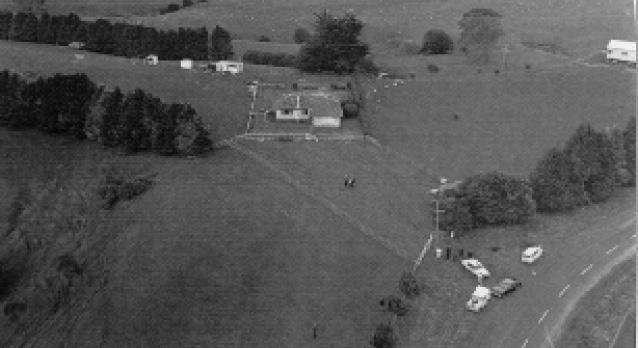
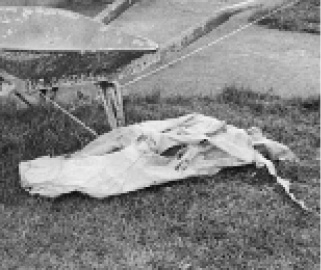
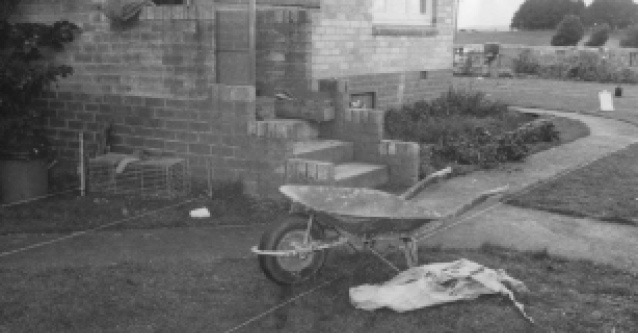
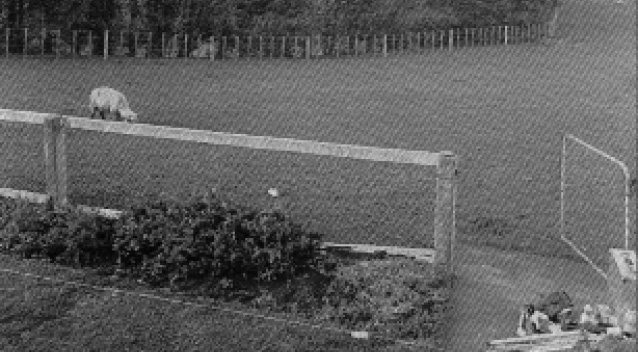
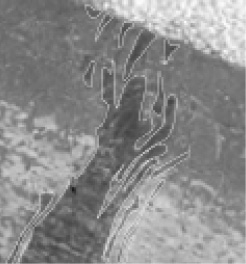
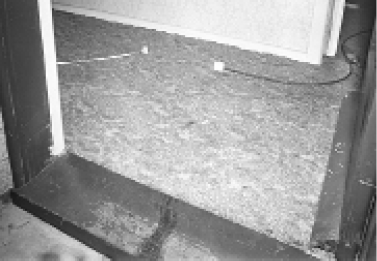
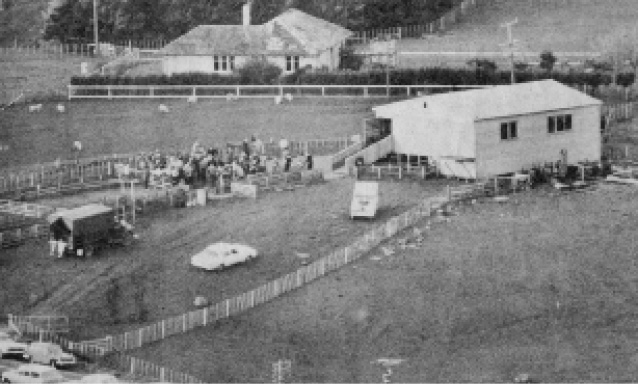

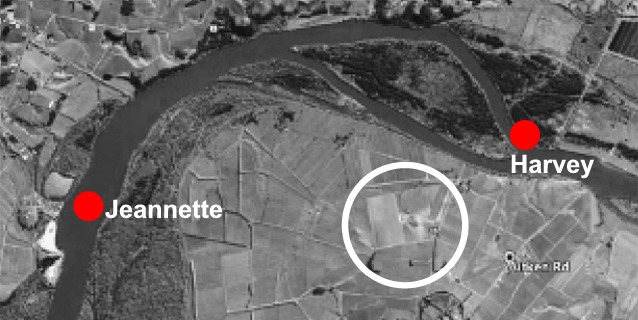


Hi in your writing you say Harvey was killed outside then taken inside, if that is in fact true wouldn’t the blood drag mark in lounge be heavier at the door then fade as he was taken in. My understanding is the blood gets fainter at the front door entrance & is heavier at his chair end of lounge. Thanks Carl
Hi Carl
A great observation. The simple answer is that John’s take on the big picture has huge credibility IMHO and that his attention to the drag mark stain on the door sill was only one of many issues he raised. The thing that is obvious to me is that the drag mark does show something bloody, most likely Harvey’s bloodied trouser legs, being dragged in not out. This is as close to a fact as you can get. The other questions and logic seem to support this contention – a .22 pistol which was easily concealable, an undefended outside killing at the gate with damage to a bush on the left and the broken bottom guard rail, the wheelbarrow rust left on the deck, widespread local knowledge that Harvey was killed outside are all positive evidence and missing urine, bullet and low blood volumes inside in a negative sense just to name a few. The simple answer is that nobody knows the full facts and the last woman alive who does know has never been asked even though John has identified her and I have her Orakei address. Asking the question why do the Police not want to investigate her may be a more productive question, but it will get you a midnight visit from the boys in blue if you do! I think John was onto it and his description makes much more sense to me than the mainstream narrative. I am aware that this is a rather defensive generalised non-specific answer to your query but is it possible that there is another explanation? An outside killing and dragging in seems certain to me.